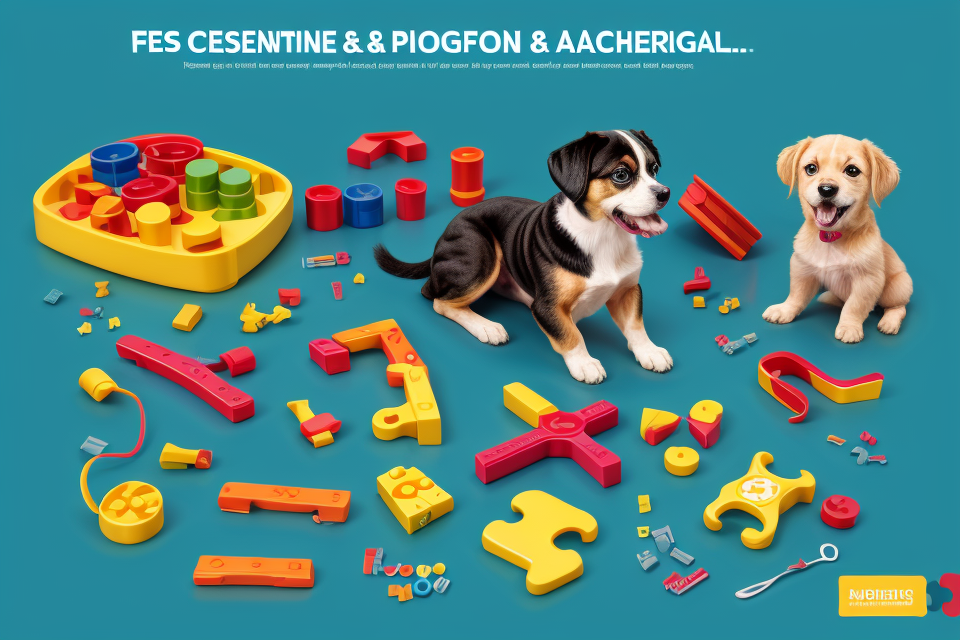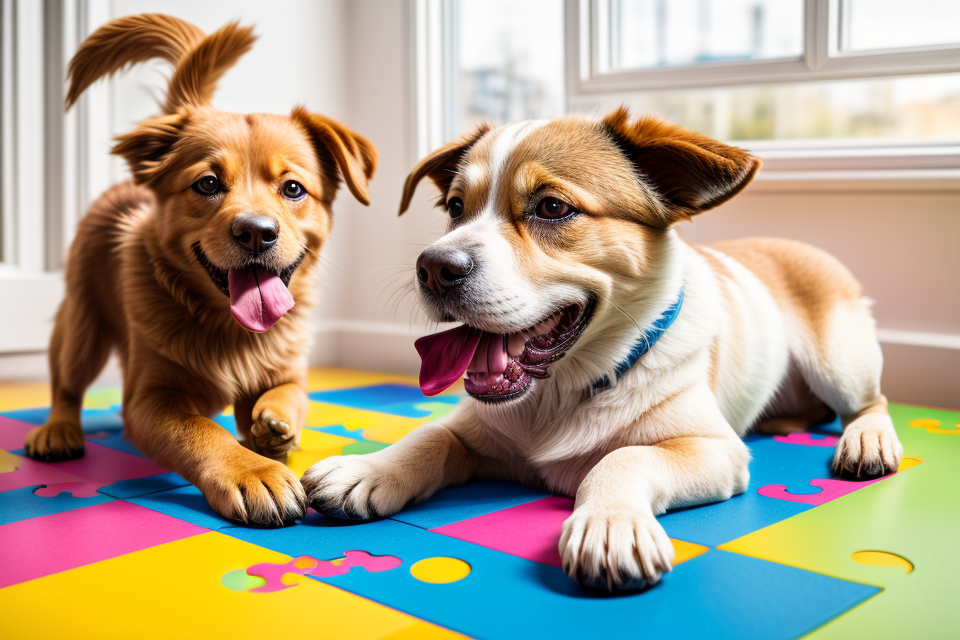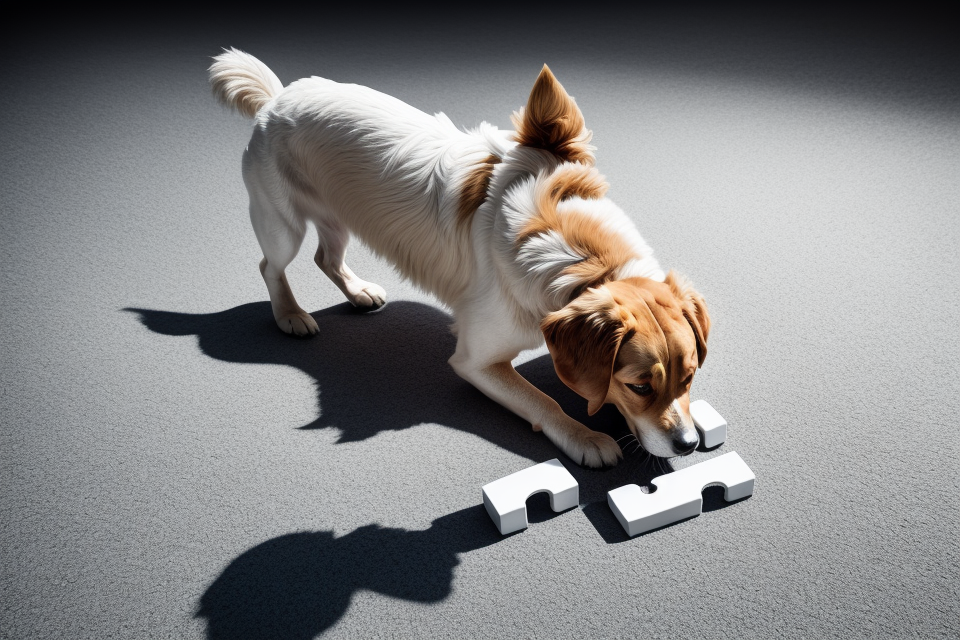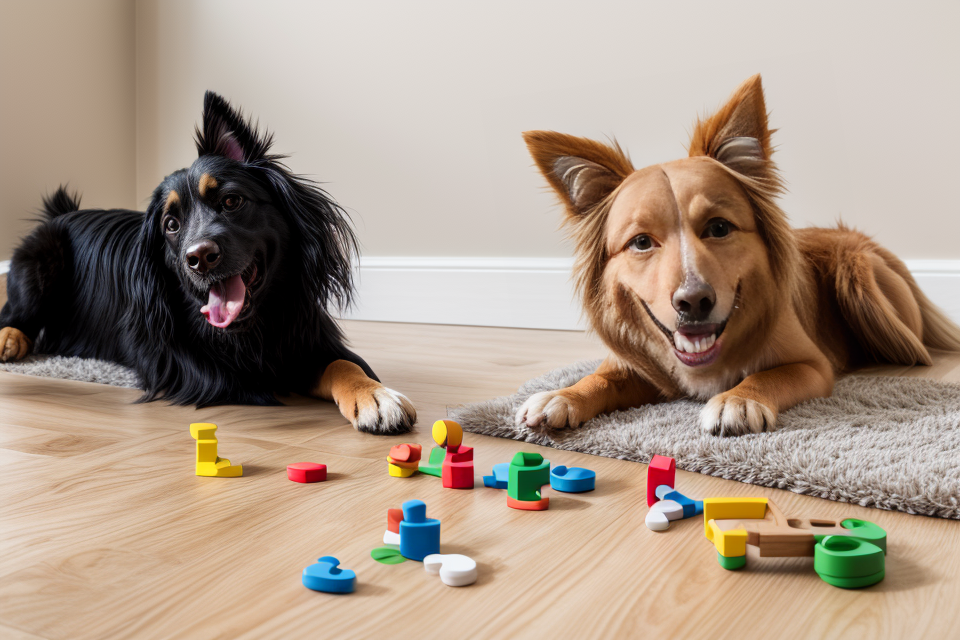Do puzzle toys really frustrate dogs? This is a question that has been debated among pet owners and animal experts for years. Some believe that puzzle toys are a great way to challenge and stimulate a dog’s mind, while others argue that they can cause frustration and stress. In this comprehensive study, we will explore the pros and cons of puzzle toys for dogs, and determine whether they really do frustrate our furry friends. So, let’s dive in and find out what the latest research has to say on this topic.
Based on the available research, the answer to whether puzzle toys frustrate dogs is not clear-cut. Some studies suggest that dogs can become frustrated when they are unable to figure out how to access the reward inside a puzzle toy, while others indicate that dogs find puzzle toys enjoyable and do not experience frustration. However, it is important to note that each dog is an individual and may have their own unique reaction to puzzle toys. Some dogs may become frustrated, while others may find them challenging and enjoyable. Ultimately, it is up to the dog owner to observe their dog’s behavior and determine whether puzzle toys are a suitable form of enrichment for their pet.
Understanding Puzzle Toys for Dogs
Types of Puzzle Toys
Dogs are known to be intelligent animals, and providing them with mental stimulation is crucial for their overall well-being. Puzzle toys for dogs are designed to challenge their cognitive abilities and keep them mentally stimulated. There are several types of puzzle toys available for dogs, each with its unique features and benefits.
Interactive Puzzle Toys
Interactive puzzle toys are designed to encourage dogs to use their problem-solving skills. These toys typically involve some sort of obstacle or challenge that the dog must overcome to access a reward. Examples of interactive puzzle toys include the “food puzzle” toys, which require the dog to figure out how to move food around to get it out of a toy, and the “hide and seek” toys, which require the dog to use its sense of smell to find hidden treats.
Food-Dispensing Puzzle Toys
Food-dispensing puzzle toys are designed to slow down a dog’s eating speed and encourage it to use its problem-solving skills. These toys typically have compartments that hold treats, and the dog must figure out how to access the treats by manipulating the toy. Some food-dispensing puzzle toys are designed to be filled with dry kibble, while others are designed to be filled with wet food or treats.
Hide-and-Seek Puzzle Toys
Hide-and-seek puzzle toys are designed to encourage dogs to use their sense of smell to find hidden treats. These toys typically have several compartments or chambers that hold treats, and the dog must use its sense of smell to figure out where the treats are hidden. Some hide-and-seek puzzle toys are designed to be filled with dry kibble, while others are designed to be filled with wet food or treats.
In conclusion, puzzle toys for dogs are a great way to provide mental stimulation and challenge their cognitive abilities. With the variety of types of puzzle toys available, dog owners can choose the ones that best suit their dog’s interests and needs.
Benefits of Puzzle Toys for Dogs
- Mental stimulation: Puzzle toys for dogs provide mental stimulation that helps to keep their minds active and prevent boredom. These toys challenge dogs to think and problem-solve, which can help to prevent cognitive decline and keep their minds sharp.
- Reduced boredom and destructive behavior: Bored dogs can become destructive, chewing on furniture, shoes, and other items in the home. Puzzle toys provide a way to keep dogs engaged and entertained, reducing the likelihood of destructive behavior.
- Strengthened bond between dog and owner: Puzzle toys for dogs can also help to strengthen the bond between a dog and its owner. By working together to solve a puzzle, dogs and their owners can develop a stronger relationship and build trust. Additionally, puzzle toys can be a fun activity for owners to participate in with their dogs, creating positive memories and strengthening the bond between them.
How to Choose the Right Puzzle Toy for Your Dog
Choosing the right puzzle toy for your dog is essential to ensure that they have a positive experience and do not become frustrated. Here are some factors to consider when selecting a puzzle toy for your dog:
- Consider your dog’s size, breed, and age: Different dogs have different needs and abilities. For example, a small dog may have difficulty manipulating a large puzzle toy, while a large dog may quickly become bored with a toy designed for smaller dogs. Breed also plays a role, as some breeds are known for their intelligence and may require more mentally stimulating toys. Age is also a factor, as puppies and senior dogs may have different needs than adult dogs.
- Look for durable and safe materials: Puzzle toys should be made from durable materials that can withstand the teeth and claws of your dog. Additionally, the materials should be safe for your dog to chew on and should not contain any harmful chemicals or materials.
- Choose toys that match your dog’s interests and abilities: Dogs have different interests and abilities, so it’s important to choose a puzzle toy that matches your dog’s preferences. For example, if your dog loves to play with food, a puzzle toy that dispenses treats may be a great choice. If your dog enjoys puzzles and problem-solving, a toy that requires them to figure out how to access the treats may be more appropriate. Consider your dog’s current level of skill and challenge them appropriately to prevent frustration.
The Effects of Puzzle Toys on Dog Behavior
Positive Effects
Puzzle toys for dogs have been found to have numerous positive effects on a dog’s behavior, which are as follows:
Increased problem-solving skills
Dogs have a natural instinct to use their noses and paws to investigate and interact with their environment. Puzzle toys tap into this instinct by requiring dogs to use their problem-solving skills to figure out how to access the treats or rewards hidden inside. This type of play encourages dogs to think creatively and use their brains in new ways, which can lead to increased confidence and independence.
Reduced stress and anxiety
Many dogs suffer from separation anxiety or general anxiety, which can lead to destructive behaviors such as chewing or digging. Puzzle toys can provide a calming outlet for these dogs by keeping their minds engaged and focused on something positive. The act of figuring out how to access the treats can be highly rewarding and can help to reduce stress and anxiety levels in dogs.
Improved physical health through increased activity
Puzzle toys can also help to improve a dog’s physical health by encouraging them to move around and play more. Many dogs love the challenge of figuring out how to access the treats hidden inside the toy, which can lead to increased activity levels and improved cardiovascular health. Additionally, puzzle toys can help to satisfy a dog’s natural instinct to forage for food, which can help to prevent overeating and obesity.
Overall, the positive effects of puzzle toys on a dog’s behavior are numerous and can have a significant impact on their mental and physical well-being.
Negative Effects
- Frustration and discouragement:
- Dogs may become frustrated when they are unable to figure out how to retrieve the treat from the puzzle toy, leading to feelings of discouragement and a decrease in motivation to interact with the toy.
- This frustration can lead to behavioral issues such as destruction of the toy or other objects in the environment, as well as increased barking or whining.
- Unrealistic expectations from owners:
- Owners may have unrealistic expectations for their dogs to quickly master puzzle toys, leading to frustration for both the dog and the owner.
- This can result in the dog becoming less interested in interacting with the toy, and the owner may feel disappointed or frustrated with the dog’s lack of progress.
- Potential for increased aggression in some dogs:
- Some dogs may become aggressive when they are unable to retrieve the treat from the puzzle toy, particularly if they are already prone to aggression or frustration.
- This aggression can manifest as growling, snapping, or biting, which can be dangerous for both the dog and the owner.
- It is important for owners to monitor their dog’s behavior and to remove the puzzle toy if any signs of aggression are observed.
Training and Socialization Techniques for Dogs Playing with Puzzle Toys
Positive Reinforcement
- Rewarding good behavior with treats or praise:
- Providing treats or praise when your dog successfully figures out how to get the toy out of the puzzle toy
- Reinforcing good behavior helps your dog associate puzzle toys with positive experiences
- This approach can encourage your dog to be more interested in puzzle toys and play with them more often
- Building a strong relationship with your dog:
- Positive reinforcement training strengthens the bond between you and your dog
- Playing with puzzle toys together can be a fun way to spend time with your dog and reinforce your relationship
- Building a strong relationship with your dog can help with training and socialization in other areas as well
- Encouraging repeat behavior:
- Consistently reinforcing good behavior when playing with puzzle toys can encourage your dog to repeat the behavior in the future
- Reinforcement helps your dog understand what behaviors are expected of them when playing with puzzle toys
- Encouraging repeat behavior can help your dog become more skilled at playing with puzzle toys over time
Setting Limits and Boundaries
- Ensuring safety during playtime
- Preventing frustration and aggression
- Teaching appropriate behavior around puzzle toys
Setting limits and boundaries is a crucial aspect of training and socializing dogs when they engage with puzzle toys. By establishing clear guidelines, owners can prevent potential safety hazards, minimize frustration in dogs, and encourage appropriate behavior around these toys.
Here are some key considerations for setting limits and boundaries:
Ensuring Safety During Playtime
- Supervise your dog when playing with puzzle toys to prevent any accidents or injuries.
- Keep a close eye on your dog to ensure they are not swallowing or chewing on any small parts that may break off from the toy.
- Monitor your dog’s behavior and immediately stop playtime if they show signs of aggression or excessive frustration.
Preventing Frustration and Aggression
- Gradually introduce puzzle toys to your dog, starting with easier levels and gradually increasing the difficulty as they become more comfortable with the toys.
- Offer plenty of praise and rewards for their efforts, even if they don’t succeed in obtaining the treat right away.
- Encourage your dog to take breaks or switch to another activity if they become overly frustrated or agitated.
Teaching Appropriate Behavior Around Puzzle Toys
- Establish rules for playing with puzzle toys, such as not jumping on the toy or attempting to force it open.
- Reward your dog for appropriate behavior, such as being patient and allowing you to manipulate the toy.
- If your dog becomes aggressive or possessive over the toy, remove it from play and try again at a later time.
By setting limits and boundaries, you can help your dog enjoy puzzle toys in a safe and positive manner, while also teaching them important socialization and problem-solving skills.
Factors Affecting Dog Reactions to Puzzle Toys
Breed and Temperament
- Different breeds have varying degrees of interest in puzzle toys
- Herding breeds, such as Border Collies and German Shepherds, are known for their high intelligence and problem-solving abilities, and may enjoy puzzle toys as a stimulating challenge
- Working breeds, like Retrievers and Labradors, have a strong drive to please their owners and may become easily frustrated if they struggle to solve a puzzle toy
- Terrier breeds, such as the Jack Russell and Cairn Terrier, are often known for their energetic and playful personalities, and may enjoy puzzle toys as a fun and engaging activity
- High-drive breeds may become easily frustrated
- Breeds with high prey drive, such as the Sighthound breeds, may become easily frustrated with puzzle toys that do not allow them to use their natural instincts to chase and catch
- Breeds with high play drive, such as the Dalmatian and Bull Terrier, may become easily frustrated with puzzle toys that do not provide enough mental stimulation or physical exercise
- Calmer breeds may enjoy puzzle toys more casually
- Breeds with a more laid-back temperament, such as the English Bulldog and Persian Cat, may enjoy puzzle toys as a low-key activity to pass the time
- Breeds with a lower drive for mental stimulation, such as the Ragdoll and Siamese Cat, may not become as engaged with puzzle toys as breeds with a higher drive for mental stimulation
Previous Experiences and Associations
- Previous experiences with puzzle toys can greatly influence a dog’s reaction to them. If a dog has had negative experiences with puzzle toys in the past, such as becoming frustrated or failing to obtain a reward, they may develop a fear or aggression towards them. This can lead to avoidance or resistance towards attempting to interact with the toys again.
- On the other hand, if a dog has had positive experiences with puzzle toys, such as successfully obtaining a reward or receiving praise and attention from their owner, they may become more engaged and excited to interact with them in the future. Positive associations can lead to increased motivation and engagement, making puzzle toys a enjoyable and enriching activity for the dog.
It is important to consider a dog’s previous experiences and associations when introducing puzzle toys, as it can greatly impact their reaction and willingness to engage with them. Providing positive reinforcement and encouraging positive associations can help to increase a dog’s enjoyment and engagement with puzzle toys, while avoiding any situations that may cause fear or aggression.
FAQs
1. What are puzzle toys for dogs?
Puzzle toys for dogs are interactive toys designed to challenge dogs mentally and physically. These toys often require dogs to solve problems or figure out how to access hidden treats or toys.
2. Do puzzle toys frustrate dogs?
While some dogs may become frustrated with puzzle toys, especially if they are not used to them, many dogs enjoy the mental and physical stimulation they provide. In fact, many dogs look forward to playing with puzzle toys and may become anxious or upset if they are not provided with them.
3. Are puzzle toys beneficial for dogs?
Yes, puzzle toys can be beneficial for dogs in many ways. They can help to prevent boredom and keep dogs mentally and physically stimulated, which can help to reduce destructive behavior and keep dogs happy and healthy. Puzzle toys can also help to strengthen the bond between dogs and their owners, as they can be played with together.
4. How do I choose the right puzzle toy for my dog?
When choosing a puzzle toy for your dog, it is important to consider your dog’s size, strength, and ability level. You should also consider your dog’s preferences and any special needs or concerns, such as allergies or dietary restrictions. It is a good idea to start with a simple puzzle toy and gradually increase the difficulty as your dog becomes more proficient.
5. How often should I give my dog puzzle toys?
It is a good idea to give your dog puzzle toys on a regular basis, ideally several times a week. This will help to keep your dog mentally and physically stimulated and prevent boredom. You can also rotate different puzzle toys to keep things interesting for your dog.
6. Can all dogs use puzzle toys?
While most dogs can use puzzle toys, it is important to consider your dog’s individual needs and abilities. Some dogs, such as those with certain medical conditions or physical limitations, may not be able to use certain types of puzzle toys. It is always a good idea to consult with your veterinarian or a professional dog trainer to determine the best type of puzzle toy for your dog.



